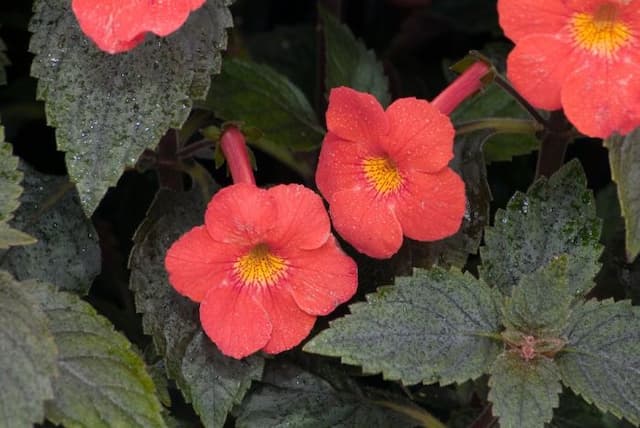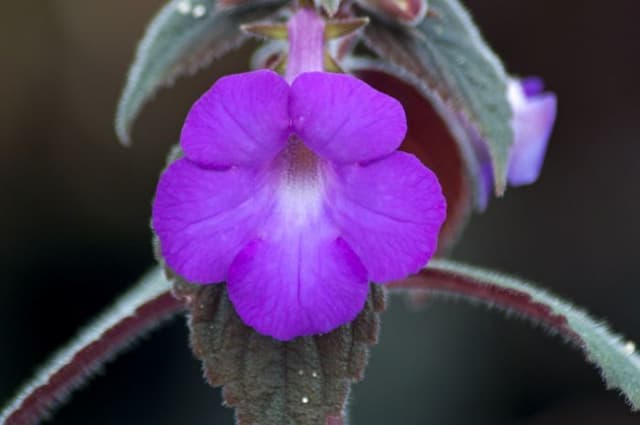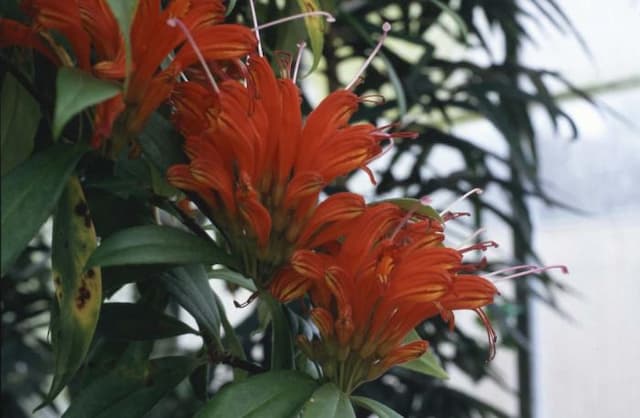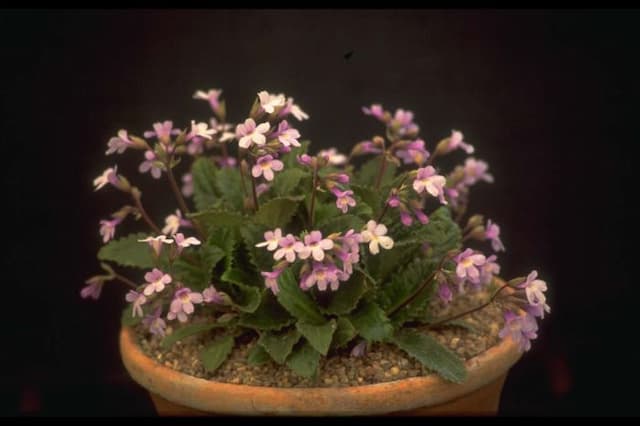Cape primrose 'Chorus Line' Streptocarpus 'Chorus Line'

ABOUT
'Chorus Line' is a rhizomatous perennial with strap-shaped hairy leaves and sprays of double, white flowers veined with blue-violet
About this plant
 Names
NamesFamily
Gesneriaceae
Synonyms
Cape Primrose, African Violet Cousin
Common names
Streptocarpus 'Chorus Line'.
 Characteristics
CharacteristicsLife cycle
Perennials
Foliage type
Evergreen
Color of leaves
Green
Flower color
Mixed
Height
6-12 inches (15-30 cm)
Spread
6-18 inches (15-45 cm)
Plant type
Herb
Hardiness zones
10
Native area
Africa
Benefits
 General Benefits
General Benefits- Easy to Care For: Streptocarpus 'Chorus Line', also known as Cape Primrose, is generally considered low-maintenance and easy to grow, making it suitable for gardeners of all skill levels.
- Aesthetic Appeal: With its beautiful blooms and attractive foliage, Cape Primrose adds vibrant color and texture to indoor spaces.
- Long Flowering Period: This plant often has an extended blooming period, which can last several months, providing a long-lasting display of flowers.
- Space Efficient: Cape Primrose is ideal for small spaces, as it doesn't require much room to thrive, making it perfect for windowsills and compact areas.
- Versatility in Display: It can be grown in hanging baskets or pots, offering flexibility in how it's displayed within the home or office.
- Diverse Varieties: The plant comes in a range of colors and patterns, giving enthusiasts the opportunity to collect and cultivate different variations.
 Medical Properties
Medical PropertiesThis plant is not used for medical purposes.
 Air-purifying Qualities
Air-purifying QualitiesThis plant is not specifically known for air purifying qualities.
 Other Uses
Other Uses- Photography and Art Subject: With their striking flowers and foliage, Streptocarpus can serve as a beautiful subject for photographers and artists looking for natural beauty to capture.
- Insect Habitat: By including Streptocarpus in a garden, one can provide a habitat for beneficial insects which contribute to pollination and pest control.
- Educational Tool: Streptocarpus can be used in educational settings to teach students about plant growth, care, propagation, and hybridization techniques due to their responsive nature to care.
- Gift Plant: Due to their attractive appearance and relatively easy care, Streptocarpus plants make thoughtful gifts for plant enthusiasts or as housewarming presents.
- Feng Shui: Some believe that placing Streptocarpus in your home can bring positive energy and add balance according to Feng Shui practices.
- Mood Enhancement: The presence of flowering plants like Streptocarpus in indoor environments can enhance mood, reduce stress, and increase feelings of well-being, according to some studies.
- Color Therapy: The vivid colors of Streptocarpus blooms can be used in color therapy to rejuvenate and inspire, as different colors are thought to affect emotions and mood.
- Floral Arrangements: The flowers of Streptocarpus can be used in small, delicate floral arrangements to bring a touch of elegance to a table setting or decor.
- Seasonal Decor: Streptocarpus can be incorporated into seasonal decor, especially during spring and summer when they are in bloom.
- Space Divider: When grown in multiple pots, Streptocarpus can serve a practical function as a living space divider in homes, offices, or cafes.
Interesting Facts
 Feng Shui
Feng ShuiThe Cape Primrose is not used in Feng Shui practice.
 Zodiac Sign Compitability
Zodiac Sign CompitabilityThe Cape Primrose is not used in astrology practice.
 Plant Symbolism
Plant Symbolism- Resilience: Streptocarpus, also known as Cape Primrose, can thrive with minimal water and in shady environments, symbolizing the ability to endure and thrive through difficult circumstances.
- Persistence: Cape Primrose often blooms for a long period, representing steadfastness and a never-give-up attitude.
- Diversity: With the wide range of colors and patterns in Cape Primrose, this plant symbolizes the beauty of diversity and variety in life.
- Delicate beauty: The soft and delicate appearance of Cape Primrose flowers suggests appreciation for subtle and understated elegance.
- Optimism: The bright and cheerful blooms are often associated with a positive outlook on life, encouraging an optimistic perspective.
 Water
WaterCape Primrose should be watered when the top inch of soil feels dry to the touch, typically once a week, but this can vary depending on environmental conditions. Use room temperature water, and water directly onto the soil to avoid wetting the leaves, which could encourage fungal diseases. It's important to provide thorough watering so that water reaches the entire root system; generally, this means using about 8-16 ounces of water for a standard 6-inch pot. Allow any excess water to drain away to prevent root rot. During the winter, reduce watering frequency as plant growth slows down.
 Light
LightCape Primrose prefers bright, indirect light to thrive, avoiding direct sunlight that can cause leaf scorch. An ideal spot is near an east-facing window where it will receive some morning sunlight but be protected from the harsh afternoon sun. If positioned in a south- or west-facing window, ensure to provide shade or use a sheer curtain to diffuse the intense light.
 Temperature
TemperatureCape Primrose enjoys moderate temperatures and should be kept in an environment ranging from 60 to 75 degrees Fahrenheit. The plant can survive minimum temperatures of 50 degrees Fahrenheit, but prolonged exposure to cold or temperatures exceeding 80 degrees Fahrenheit can be detrimental. The ideal temperature range for robust growth would be between 65 and 70 degrees Fahrenheit.
 Pruning
PruningCape Primrose should be pruned to remove any yellowed or dead leaves, which encourages healthier growth and mitigates disease risk. Prune spent flower stems at their base to promote more blooms. The best time to prune is in the spring, but it may be done anytime as needed to maintain the plant's appearance. Regularly removing fading flowers will help stimulate continuous blooming throughout the season.
 Cleaning
CleaningAs needed
 Soil
SoilThe best soil mix for Cape Primrose should be light, well-draining, and rich in organic matter. A combination of peat moss, perlite, and vermiculite in equal parts creates an ideal environment. This plant prefers a slightly acidic to neutral pH, typically between 5.5 and 6.5.
 Repotting
RepottingCape Primrose should be repotted every 12 to 18 months or when it becomes root-bound. Repotting is best done in spring or early summer to allow the plant to adjust and grow actively in the warmer months.
 Humidity & Misting
Humidity & MistingCape Primrose thrives in moderate to high humidity levels, ideally between 50% and 70%. They will appreciate a humid environment but should not be kept in overly wet conditions which can cause fungal issues.
 Suitable locations
Suitable locationsIndoor
Provide bright, indirect light and keep consistently moist.
Outdoor
Shelter from direct sun, ensure drainage, protect from frost.
Hardiness zone
10-11 USDA
 Life cycle
Life cycleThe life of a Cape Primrose (Streptocarpus 'Chorus Line') begins with the germination of seeds, which, under appropriate conditions of warmth and moisture, sprout to produce small seedlings. These seedlings then establish themselves, growing their first true leaves and developing a small rosette, usually in a shady to partially shaded location. The vegetative growth stage follows, where the plant matures, elongates, and develops a larger rosette of leaves. Upon reaching maturity, the Cape Primrose starts the flowering stage, producing beautiful, trumpet-shaped blossoms that can continue for several months if conditions are favorable. After pollination, if it occurs, the plant may produce seed pods, which, once matured, will release seeds, and the cycle can begin anew. Throughout its life, a Cape Primrose can also undergo vegetative propagation through leaf cuttings, allowing gardeners to clone the plant and produce genetically identical offspring.
 Propogation
PropogationPropogation time
Spring-Early Summer
Streptocarpus 'Chorus Line', commonly known as Cape primrose, can be propagated most easily by leaf cuttings, a technique that can be employed virtually year-round, though it might be especially successful during the warm, vibrant growth period of spring and summer. To propagate by leaf cuttings, one would typically select a healthy, mature leaf and cut it into sections, each with a portion of the main vein. These sections are then inserted into a moist, well-draining potting mix or vermiculite, ensuring the cut edge is buried slightly. It's important to maintain a humid environment, which can be achieved by covering the pot with a plastic bag or placing it in a miniature greenhouse. With the right conditions, including indirect light and stable, moderate temperatures, the leaf sections will develop roots and eventually form small plantlets at the site of the cut in about a month to a half (4-8 weeks). These plantlets can be carefully separated and potted on once they have grown sufficient roots.









